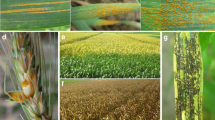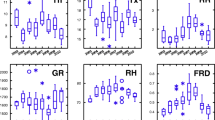Abstract
Epidemics of wheat stripe rust, caused by Puccinia striiformis f. sp. tritici (Pst), are more frequent in the regions where Pst can oversummer and overwinter. Regions for potential oversummering and overwintering of Pst were determined in the contiguous United States using a survival index (SI) ranging from 0 (most unfavorable) to 10 (most favorable) developed based on long-term weather data. The pathogen can survive in cool summer in the most regions north of latitude 40°N, particularly Washington, Idaho, Montana, Oregon and California. Due to limiting high temperatures, it survives marginally during summer in Arkansas, Delaware, Georgia, Iowa, Illinois, Indiana, Kansas, Kentucky, Massachusetts, Missouri, Ohio, Oklahoma, Rhode Island and Texas. Similarly, unfavorable hot summer restricts summer survival of the pathogen in the most regions south of 40°N except for highlands in the Rocky or Appalachian Mountains. Warm winters favor fungal survival in most regions south of 40°N and the Pacific Coast, including Alabama, Arkansas, Arizona, California, Florida, Georgia, Idaho, Louisiana, Mississippi, New Mexico, Nevada, Oregon, South Carolina, Texas and Washington. Severe winters do not allow survival in most regions north of 40°N and east of the Rocky Mountains, whereas less severe winter in Delaware, Illinois, Indiana, Kansas, Kentucky, Massachusetts, Maryland, Michigan, Missouri, North Carolina, New Jersey, New York, Ohio, Oklahoma, Pennsylvania, Rhode Island, Tennessee, Utah and Virginia permits marginal survival of Pst. Most wheat-growing regions have climatic suitability for either oversummering or overwintering. Both oversummering and overwintering can occur in the Pacific Northwest (Idaho, Oregon and Washington), Arizona, California, North Carolina, New Mexico, Pennsylvania, Virginia and West Virginia. These regions may provide primary inoculum for stripe rust epidemics in their own and surrounding regions.


Similar content being viewed by others
References
Brouwer C, Heibloem M (1986) Irrigation water management: Irrigation water needs, irrigation water management training manual No. 3. http://www.fao.org/docrep/S2022E/s2022e06.htm. Accessed 18 December 2010
Brown JKM, Hovmøller MS (2002) Aerial dispersal of pathogens on the global and continental scales and its impact on plant disease. Science 297:537–541
Burleigh JR (1965) The winter biology of Puccinia striiformis West. in the Pacific Northwest. Dissertation, Washington State University
Chen XM (2005) Epidemiology and control of stripe rust [Puccinia striiformis f. sp. tritici] on wheat. Can J Plant Pathol 27:314–337
Chen XM, Penman L, Wan AM, Cheng P (2010) Virulence races of Puccinia striiformis f. sp. tritici in 2006 and 2007 and development of wheat stripe rust and distributions, dynamics, and evolutionary relationships of races from 2000 to 2007 in the United States. Can J Plant Pathol 35:315–333
de Vallavieille-Pope C, Huber L, Leconte M, Goyeau H (1995) Comparative effects of temperature and interrupted wet periods on germination, penetration, and infection of Puccinia recondita f. sp. tritici and P. striiformis on wheat seedlings. Phytopathology 85:409–415
Dennis JI (1987a) Effect of high temperatures on survival and development of Puccinia striiformis on wheat. Trans Br Mycol Soc 88:91–96
Dennis JI (1987b) Temperature and wet-period conditions for infection by Puccinia striiformis f. sp. tritici race 104E137A +. Trans Br Mycol Soc 88:119–121
Dennis J, Brown J (1986) Summer survival of Puccinia striiformis f. sp tritici in Victoria, Australia. Aust Plant Pathol 15:57–60
Dietz SM, Hendrix JW (1962) Reaction of grasses to stripe rust at Pullman, Washington. Phytopathology 52:730
Doodson KJ, Manners JG, Myers A (1964) Some effects of yellow rust (Puccinia striiformis) on the growth and yield of spring wheat. Ann Bot 28:459–472
Ellison PJ, Murray GM (1992) Epidemiology of Puccinia striiformis f. sp. tritici on wheat in southern New South Wales. Aust J Agric Res 43:29–41
Eversmeyer MG, Kramer CL (1996) Modeling winter wheat and early spring survival of Puccinia recondita in wheat nurseries during 1980 to 1993. Plant Dis 80:490–493
Georgievskaja NA (1966) Quelques lois sur Ie developpement de la rouille Jaune du ble. Tr. Vses. Nauchno Issled. Inst Zabtsh Rost Leningrad 26:55–63
Hassebrauk K (1965) Nomenklatur, geographische Verbreitung und wirtsbereich des Gelbrostes, Puccinia striiformis West. Mitt Biol Bundesanst Land Forstwirtsch 116:1–75
Hendrix JW, Burleigh JR, Tu JC (1965) Oversummering of stripe rust at high elevations in the Pacific Northwest-1963. Plant Dis Rep 49:275–78
Hong TD, Ellis RH, Moore D (1997) Development of a model to predict the effect of temperature and moisture on fungal spore longevity. Ann Bot 79:121–128
Hungerford CW (1923) Studies on the life history of stripe rust, Puccinia glumarum. J Agric Res 24:607–20
Hungerford CW, Owens CE (1923) Specialized varieties of Puccinia glumarum and hosts for variety tritici. J Agric Res 25:363–401
Imbaby IA, Nazim M, Ali MM, Abdel-Malek NI (2005) Viability of wheat rust urediniospores produced on different stages of susceptible plants. Egypt J Phytopathol 33:59–76
Kang Z, Zhao J, Han D, Zhang H, Wang X, Wang C, Han Q, Guo J, Huang L (2010) Status of wheat rust research and control in China. BGRI 2010 Technical Workshop, May 30–31 2010, St Petersburg, Russia. http://www.globalrust.org/db/attachments/bgriiwc/24/2/07-kang-ca-A4-embargo.pdf. Accessed 14 December 2010
Li ZQ, Zeng SM (2002) Wheat rusts in China. China Agricultural, Beijing
Line RF (2002) Stripe rust of wheat and barley in North America: a retrospective historical review. Annu Rev Phytopathol 40:75–118
Line RF, Qayoum A (1992) Virulence, aggressiveness, evolution, and distribution of races of Puccinia striiformis (the cause of stripe rust of wheat) in North America, 1968–87. Technical Bulletin Number 1788. United States Department of Agriculture, Agricultural Research Service
Ma ZH, Shi SD, Jiang YY, Zhao ZH (2005) Climate-based regional classification for oversummering of Puccinia striiformis in China with GIS. Acta Phytopathol Sin 34:455–462
Maddison AC, Manners JG (1973) Lethal effects of artificial ultraviolet radiation on cereal rust uredospores. Trans Br Mycol Soc 60:471–494
McCracken FI, Burleigh JR (1962) Influence of light and temperature on in vitro germination of Puccinia striiformis uredospores. Phytopathology 52:742
Murray GM, Ellison PJ, Watson A, Cullis BR (1994) The relationship between wheat yield and stripe rust as affected by length of epidemic and temperature at the grain development stage of crop growth. Plant Pathol 43:397–405
Naoumova NAM (1937) Natural fluctuations of temperature and the duration of the incubation period of Puccinia glumarum f. sp. tritici. Zaschita Rasteniy 12:51–66
Peel MD, Riveland N (1977) Winter wheat production in North Dakota. Extension bulletin 33. http://www.ag.ndsu.edu/pubs/plantsci/smgrains/eb33w.htm. Accessed 5 May 2011
Rapilly F (1979) Yellow rust epidemiology. Annu Rev Phytopathol 17:59–73
Shaner G, Powelson RL (1971) Epidemiology of stripe rust of wheat, 1961–1968. Oreg Agric Exp Stn Tech Bull 117
Shaner G, Powelson RL (1973) The oversummering and dispersal of inoculum of Puccinia striiformis in Oregon. Phytopathology 63:13–17
Sharma-Poudyal D, Chen XM (2011) Models for predicting potential yield loss of wheat caused by stripe rust in the US Pacific Northwest. Phytopathology 101:544–554
Sharp EL (1965) Prepenetration and postpenetration environment and development of Puccinia striiformis on wheat. Phytopathology 55:198–203
Sharp EL, Hehn ER (1963) Overwintering of stripe rust in winter wheat in Montana. Phytopathology 53:1239–40
Shi SD, Ma ZH (2005) Climate-based regional classification for overwintering of Puccinia striiformis in China with GIS and geostatistics. ACTA Phytophylacica Sinica 32:29–32
Smilanick JL, Mansour MF (2007) Influence of temperature and humidity on survival of Penicillium digitatum and Geotrichum citri-aurantii. Plant Dis 91:990–996
Stakman EC (1934) Epidemiology of cereal rusts. Proceedings of the Fifth Pacific ScienceCongress (Canada), 1933, vol 4, University of TorontoPress, Toronto, pp 3177–3184
Stubbs RW (1985) Stripe rust. In: Roelfs AP, Bushnell WR (eds) The cereal rusts, vol II. Diseases, distribution, epidemiology, and control. Academic, Florida, pp 61–101
Sutton JC (1988) Predictive value of weather variables in the epidemiology and management of foliar diseases. Fitopatol Bras 13:305–12
Theobald DM (2005) GIS concepts and ArcGIS methods, 2nd edn. Conservation Planning Technologies, Fort Collins
Tollenaar H, Houston BR (1966) Effect of temperature during uredospore production and light on in vitro germination of urediniospores of Puccinia striiformis. Phytopathology 56:787–790
Tollenaar H, Houston BR (1967) A study on the epidemiology of stripe rust, Puccinia striiformis West., in California. Can J Bot 45:291–307
Tu JC (1967) The summer biology of Puccinia striiformis West. In Southeastern Washington. Dissertation, Washington State University
Wang H, Yang XB, Ma Z (2010) Long-distance spore transport of wheat stripe rust pathogen from Sichuan, Yunnan, and Guizhou in southwestern China. Plant Dis 94:873–880
Zadoks JC (1961) Yellow rust on wheat, studies in epidemiology and physiologic specialization. Neth J Plant Pathol 67:69–256
Zadoks JC (1965) Epidemiology of wheat rust in Europe. FAO Plant Prot Bull 13:97–108
Acknowledgments
This research was supported by the US Department of Agriculture, Agricultural Research Service (Project No. 5348-22000-014-00D) and Washington State University (Project No. 13C-3061-3925 and 13C-3061-3232) PPNS No. 0580, Department of Plant Pathology, College of Agricultural, Human, and Natural Resource Sciences, Agricultural Research Center, Project Number WNP00663, Washington State University, Pullman, WA 99164–6430, USA. We would like to thank Drs. D. A. Johnson and T. D. Murray for critical review of the manuscript.
Author information
Authors and Affiliations
Corresponding author
Rights and permissions
About this article
Cite this article
Sharma-Poudyal, D., Chen, X. & Rupp, R.A. Potential oversummering and overwintering regions for the wheat stripe rust pathogen in the contiguous United States. Int J Biometeorol 58, 987–997 (2014). https://doi.org/10.1007/s00484-013-0683-6
Received:
Revised:
Accepted:
Published:
Issue Date:
DOI: https://doi.org/10.1007/s00484-013-0683-6




